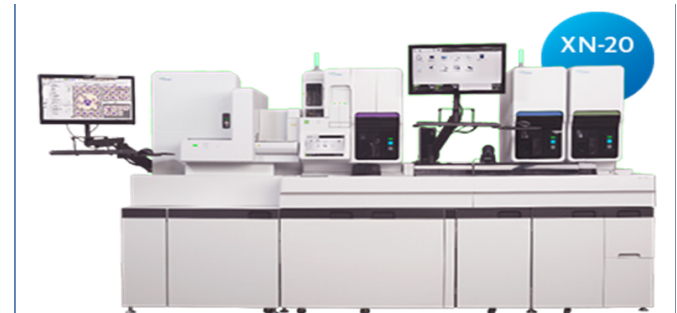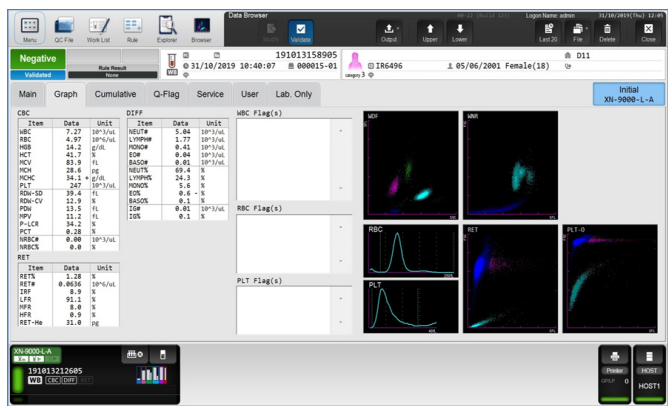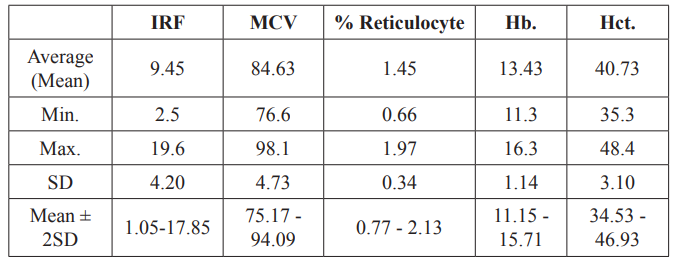The Average of IRF in Normal CBC and Reticulocyte Count by XN-10/20
Author'(s): Wuttichai Suksanit1*, Yotsombat Changtrakul1 and Kutcharin Phunikhom1,2
1 Department of Diagnostic Microscopy Unit, Srinagarind Hospital, Faculty of Medicine, Khon Kaen University, Thailand.
2 Department of Pharmacology, Faculty of Medicine, Khon Kaen University, Thailand.
*Correspondence:
Wuttichai Suksanit, Department of Diagnostic Microscopy Unit, Srinagarind Hospital, Faculty of Medicine, Khon Kaen University, Thailand.
Received: 29 January 2020; Accepted: 27 February 2020
Citation: Wuttichai Suksanit, Yotsombat Changtrakul, Kutcharin Phunikhom. The Average of IRF in Normal CBC and Reticulocyte Count by XN-10/20. Cancer Sci Res. 2020; 3(1); 1-2.
Keywords
Introduction
The Diagnostic Microscopy Unit have been providing Complete Blood Count (CBC) and Immature Reticulocyte Fraction (IRF) services on a daily basis. The CBC analysis is important in helping doctors diagnose. Or monitor the treatment of patients correctly and efficiently. At present, doctors give importance Of the IRF detection which is important in helping physicians to understand the patho-physiology of red cell. The IRF test can be used to monitor the treatment of anemia patients, such as anemia caused by iron deficiency, Chronic renal disease patients receiving Erythropoietin (EPO) cancer patients receiving EPO. The CBC analysis at the Diagnostic Microscopy unit brought an automated blood and platelet analyzer base on four principles of analysis are:
- The principle of Fluorescence Flow Cytometry Method using semi-conductor laser in combination with fluorescent Enables white blood cell count, NRBC and white blood cell classification, Reticulocyte count including Reticulocyte count and embryo platelet count.
- The principle of Hydrodynamic Focusing Direct Current Method is used to detect red blood cell count and platelet
- The principle of Cumulative Pulse Height Detection Method is used to measure the hematocrit.
- The principle of SLS-Hemoglobin Method for determination of hemoglobin.
By analyzing the CBC with such a machine, there has been a lot of progress in the laboratory. The doctor can bring the results of the diagnosis to diagnose patients precisely and quickly. Or as screening for certain diseases together with symptoms and other tests. The useful in the prognosis Follow disease progression It is clinically important to be able to help doctors diagnose patients correctly. In the department have no studies have been conducted regarding reference values in normal group which can report the analysis results directly from the XN-10/20. The author is interested in studying the IRF values in people with CBC and Reticulocyte values. Within the normal range of 50 cases (Male = 14, Female =36, age between 11-69 years old). Reference to the normal values from ISLH. And the relevant values as follows:
- Low fluorescence ratio (LFR) is the value of red blood cells. Larvae that are dyed low in fluorescent color.
- Middle or medium fluorescence ratio (MFR) is the value of erythrocytes of the embryo that are dyed with fluoride in medium volume.
- High fluorescence ratio (HFR) is the value of embryonic red blood cells that are dyed high in fluorescent colors.
- Immature reticulocyte fraction (IRF) is a value consisting of the HFR and MFR groups, the result Can be used to study the pathology of red blood cell formation or can be used to monitor the treatment of anemia patients.
- RET% or Reticulocyte% refers to the percentage of total Reticulocyte in red blood cells.
- Mean Corpuscular Volume (MCV) means the average volume of red blood cells ( fl).
- Hemoglobin (Hb) refers to the amount of hemoglobin in red blood cells (g / dl).
- Hematocrit (Hct%) means red blood cell volume (%).
Aim of the study
In order to find the average of the IRF in the samples with the Complete Blood Count (CBC) and Reticulocyte count, with the normal value with the XN-10/20 by referring to the normal value from International Society for Laboratory Hematology (ISLH), which installs the ISLH standards in the machine's program, ready for analysis.
Materials and Methods
- Automatic blood analyzer and platelets model XN-10/20
- Specimens for CBC and Reticulocyte count at diagnostic microscopy for 50 cases.
- The immature reticulocyte fraction (IRF) data obtained from the XN-10/20. (Recorded age, sex).
- Record and use the data to calculate Mean, Min, Max,
- Calculate the reference value from the Mean ± 2SD
- Analyze data and summarize and review study
Results
From the specimen data examined for CBC and Reticulocyte count in 50 cases (14 males and 36 females, aged between 11-69 years old) were test with Sysmex XN-10/20 (Figure 1).

Figure 1: Sysmex XN-10/20 Automatic Blood and Platelet Analyzer.

Figure 2: Data values including the immature reticulocyte fraction (IRF) obtained from the XN-10/20.
The data were record from the system (Figure 2). The IRF has Mean = 9.45, Min = 2.50, Max = 19.60, SD = 4.20; MCV has Mean = 84.63, Min = 76.60, Max = 98.10, SD = 4.73; RET% has Mean = 1.45, Min = 0.66, Max = 1.97, SD = 0.34; Hemoglobin has Mean = 13.43, Min = 11.30, Max = 16.30, SD = 1.14; Hematocrit% has Mean = 40.73, Min = 35.30, Max = 48.40, SD = 3.10. The reference value from the Mean ± 2SD formula, IRF = 1.05-17.85; RET% = 0.77-2.13; MCV value = 75.17-94.09; Hemoglobin value= 11.15-15.71 and Hemoglobin value = 34.53-46.93 (Table 1).

Table 1: Mean, Max., Min., SD of IRF, MCV, % Reticulocyte, Hemoglobin (Hb.) and Hematocrit (Hct.) in N=50.
Conclusion
Based on the data from the average immature reticulocyte fraction (IRF), currently, doctors pay more attention and check for the Immature reticulocyte fraction (IRF). Because it is important to help doctors know the pathology of red blood cell formation. To monitor the treatment of anemia patients, such as anemia caused by iron deficiency Chronic renal disease patients receiving Erythropoietin (EPO), cancer patients receiving EPO and others. In the sample that came to check the CBC and Reticuloctye count at the microscopy Srinagarind Hospital Faculty of Medicine Khon Kaen University, Thailand. The normal level by referring to the normal value from the ISLH Criteria. And in this study, the researchers used the values of MCV, Hb, Hct. It determines the normal values of the sample being studied together with the analysis values from the XN-10/20. No abnormal flag (consisting of WBC Flag (s), RBC Flag (s), PLT Flag (s)), no warning 50 cases (14 male and 36 female).
From the study, it is found that the mean or reference value from the Mean ± 2SD of IRF is 1.05-17.85; The Reticulocyte percentage (RET%) was 0.77-2.13; MCV values was 75.17 - 94.09; Hemoglobin was 11.15 - 15.71 and Hematocrit was 34.53 - 46.93. In this study, the author aims to provide relevant personnel especially medical technicians who must report the results of the reticulocyte count and IRF values to be aware of the importance and see the relationship of the above values with other results. In order to get accurate results according to professional standards.
References
- Davis BH. Immature reticulocyte fraction IRF by any name, a useful clinical parameter of erythropoietic activity. Lab Hematol. 1996; 2: 2-8.
- Standard Operating Procedure Automated Hematology Analyzer Xn-9202. 2-11.
- International Society for Laboratory Hematology (ISLH); 1990.